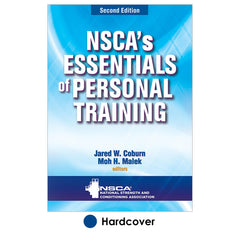Helping a client after total knee arthroplasty
This is an excerpt from NSCA'S Essentials of Personal Training - 2nd Edition by NSCA -National Strength & Conditioning Association.
Total Knee Arthroplasty
Years of repetitive loading to the human knee can result in degeneration and degradation of the joint surfaces of the distal femur and proximal tibia. Often the degeneration is specifically located on either the medial or the lateral side of the knee joint, based on wear patterns and more specifically the individual's lower extremity alignment. People who are excessively bow-legged (genu varum) or knock-kneed (genu valgum), or who have had serious injury to the knee (such as extensive fractures through the joint, meniscal pathology, or instability of the knee due to unrepaired or failed repair of ligamentous structures), are often candidates for a total knee replacement.
Total knee arthroplasty (TKA) requires extensive exposure of the joint with a large central incision. Prosthetic components are selected and inserted to cover the worn areas at the ends of both the femur and tibia. Rehabilitation begins immediately with a ROM focus. Individuals perform open and closed kinetic chain exercises initially in the hospital and at home prior to formal outpatient rehabilitation.
Movement and Exercise Guidelines
Following discharge from formal rehabilitation, clients often have 100° to 120° of knee flexion and nearly complete knee extension. Indications for exercise include cycling, swimming, and endurance-based activities that minimize joint impact loading and improve muscular and cardiovascular function and fitness levels. Specific exercises such as leg press, multidirection hip strengthening, calf raises, and knee flexion and extension exercises using a low resistance and high repetition format are recommended. As an example, lunges onto a BOSU ball (figure 21.16) are not only a strategy for strengthening; they also benefit balance and proprioception for the entire kinetic chain.
Again, closed kinetic chain exercises that place the knee in greater than 100° of flexion are risky and impose added stresses on the knee. Further, because kneeling is generally contraindicated during the first few weeks following TKA, it is necessary for clients to avoid exercises requiring that position (e.g., kneeling lat pulldown, bent-over dumbbell row using a bench) or exercises that may cause them to kneel inadvertently (e.g., lunges performed too deeply). Exercises using less than 90° knee flexion postures are recommended in both open and closed kinetic chain exercises.
Read more from NSCA's Essentials of Personal Training, Second Edition By the National Strength & Conditioning Association.
More Excerpts From NSCA'S Essentials of Personal Training 2nd Edition

Get the latest insights with regular newsletters, plus periodic product information and special insider offers.
JOIN NOW


